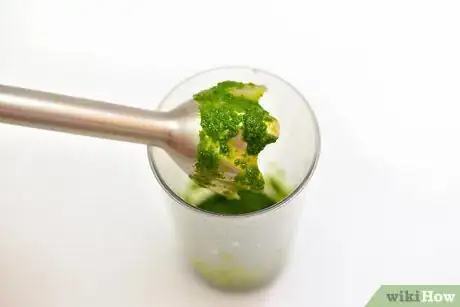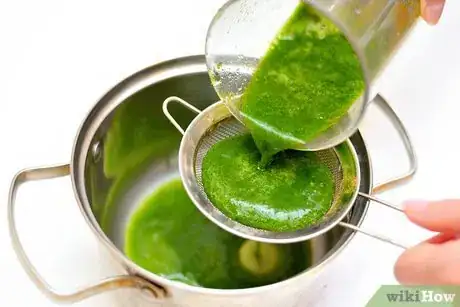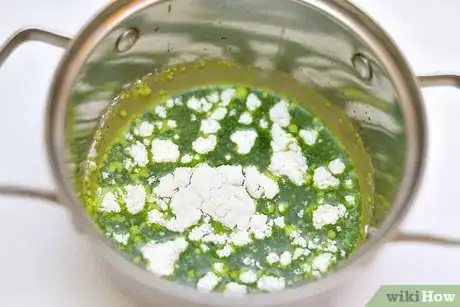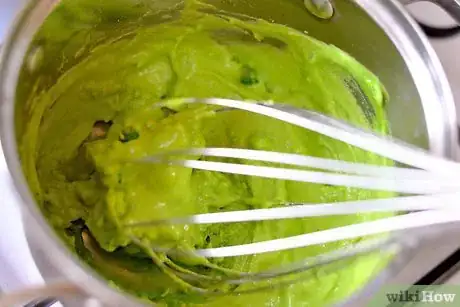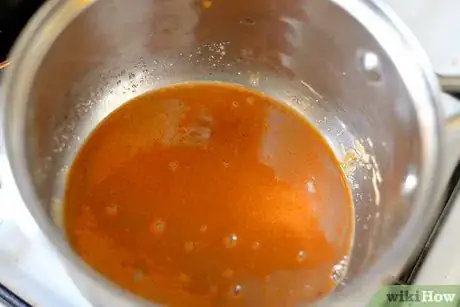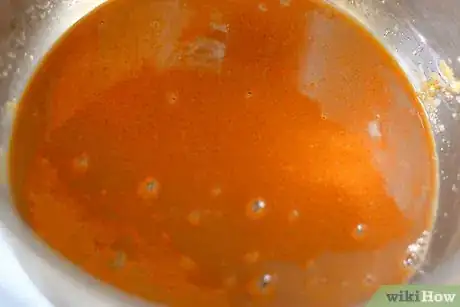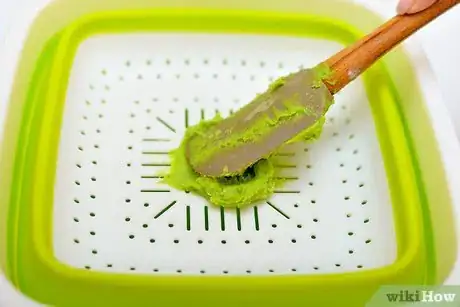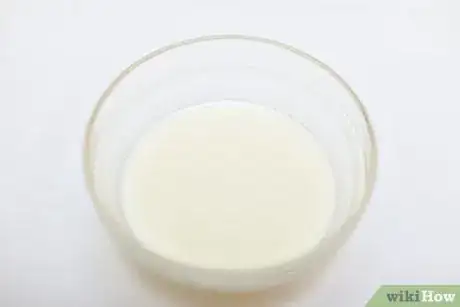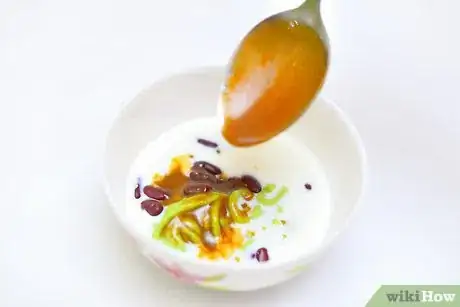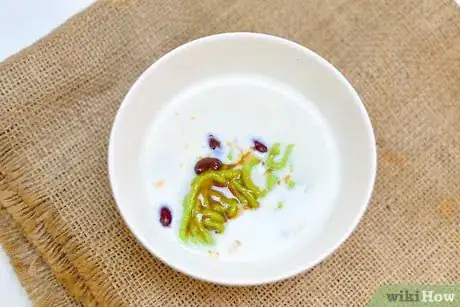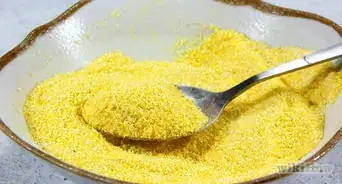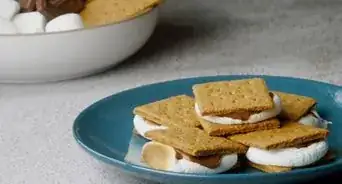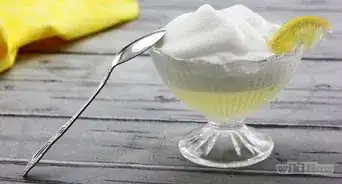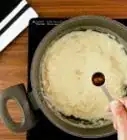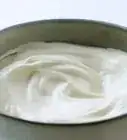This article was co-authored by wikiHow Staff. Our trained team of editors and researchers validate articles for accuracy and comprehensiveness. wikiHow's Content Management Team carefully monitors the work from our editorial staff to ensure that each article is backed by trusted research and meets our high quality standards.
There are 9 references cited in this article, which can be found at the bottom of the page.
This article has been viewed 55,006 times.
Learn more...
Cendol is type of traditional dessert often served in Malaysia,Indonesia and parts of Singapore, Thailand and Burma. It consists of small green jelly-like noodles sweetened with palm sugar syrup and coconut milk and served chilled. The term “cendol” refers to the green noodles, which are made with rice flour and can be served many different ways. Most of the work of preparing cendol goes into making the noodles themselves, which can then be enjoyed with cool, refreshing toppings.
Ingredients
Cendol Noodles
- 8-10 large pandan leaves
- 20 ounces water (600g)
- 3-4 ounces rice flour (100g)
- 2 ounces tapioca flour (50g)
- 1/2 ounce mung bean flour (10g)(if available)
Palm Sugar Syrup
- 1 package gula melaka
- 1 ounce brown sugar (28g)
- 1/2-1 ounce water (20g)
- Additional pandan leaves (to taste)
Additional
- Coconut milk
- Sliced jackfruit, durian or red beans
- Shaved ice
Steps
Making the Green Jelly Noodles
-
1Blend the pandan leaves with water. Cut the pandan leaves into small pieces to prepare them for blending. Place the pandan leaves in a blender with around 20 ounces (about 600 grams) of water. Blend at a high speed to infuse the water with the color and aroma of the pandan leaves. No large chunks or pieces of the leaves should remain.[1]
- If you’re short on time or don’t want to go to the trouble of blending fresh pandan leaves, look for pandan extract at your local Asian supermarket.
-
2Strain the water into a shallow pot. Position a fine mesh strainer over a pot or saucepan on the stovetop. Pour the pandan leaf-infused water through the strainer to catch any leftover fibrous pieces. Stir the water in the pot to check for stray chunks or inconsistencies in texture.[2]
- The water should be a rich grass green color once the pandan leaves have been blended in.
Advertisement -
3Add the rice, mung bean and tapioca flour. Scoop 3-4 ounces (100g) of rice flour, 2 ounces of (50g) tapioca flour and half an ounce (10g) of mung bean flour into the pot with the pandan water. Stir the mixture together with a spoon until the flour is evenly distributed.[3]
- Traditionally, cendol is made using mung bean flour and/or rice flour. Mung bean flour can be harder to find, but is easily substituted using ordinary rice flour alone.
- A little tapioca flour can help thicken the jelly noodles and give them the right firm, chewy texture.
-
4Simmer and stir to thicken. Turn the stove on to a low heat. Allow the cendol ingredients to warm up, stirring occasionally. As it heats, the mixture will turn into a thick paste. Keep the heat low to prevent scorching the cendol mixture.[4]
- Thickening the cendol mixture may take 10-15 minutes, possibly longer. The water has to slowly evaporate before the mixture can set up into a batter.
Simmering the Palm Sugar Syrup
-
1Combine the ingredients in a saucepan. In a separate saucepan, add the gula melaka, brown sugar and water. Add any remaining whole pandan leaves to infuse the syrup with their flavor, if you wish. For more authenticity and a more complex taste, add a splash of lye or alkaline water.[5]
- Gula melaka is a product of southeast Asian origin. It is made by boiling and condensing the sap from the date, coconut or sago palm and using it as a sweetener.[6]
- Gula melaka comes packaged as a solid block. Use a knife to shave away small sections of the gula melaka so that it will be easier to work with.[7]
-
2Cook the mixture until the gula melaka and sugar melt down. Heat the gula melaka, brown sugar, water and pandan leaves at a medium temperature. The gula melaka and sugar will melt quickly, so keep an eye on the saucepan to make sure the mixture doesn’t burn. Stir the mixture as it cooks down.[8]
- Supplementing the gula melaka with brown sugar will give the palm sugar syrup a rich caramel flavor while cutting down on the bitterness of the palm.
- More pandan leaves are sometimes added to the palm sugar syrup as it cooks, but they are not required.
-
3Reduce the heat and simmer. Turn the stove top down to the lowest setting and let the palm sugar syrup mixture continue to simmer as you finish preparing the cendol. Break up any remaining lumps in the gula melaka or brown sugar. The longer the mixture simmers, the smoother consistency it will have and the better represented each of the flavors will be.[9]
- The palm sugar syrup should have a similar consistency to warm maple syrup. If the syrup becomes too thick as it simmers, add more water slowly. By the time it’s finished simmering, it should be thin enough to easily pour over the cendol.
-
4Set aside to cool. Remove the saucepan from the heat and set it aside. Let the palm sugar syrup begin cooling. This part of the process can be done while you’re straining or chilling the cendol so that the syrup will still be warm once it’s time to serve.[10]
- Don’t let the palm sugar syrup cool down too much. At room temperature, it will congeal and begin to harden. If this happens, simply add a splash of water and reheat it until it melts and thins out again, stirring frequently.
Serving the Cendol
-
1Strain the cendol into cold water. Fill a bowl with cold water and ice cubes. Pour the thickened cendol mixture into a pasta strainer. Then, use a spoon or other implement with a broad, slightly curved surface to force the cendol through the holes in the strainer a little at a time. You may have to wet the spoon periodically to keep the cendol from sticking.[11]
- The ice water will cause the cendol to become firm so that the noodles will hold their shape.
- A potato ricer can also be used to more easily strain the cendol noodles.[12]
-
2Ready the coconut milk. In a separate saucepan, bring 1-2 cups of coconut milk to a boil briefly. This will eliminate any bacteria if the milk is raw or untreated and can keep it from spoiling as quickly. Reduce the heat gradually and let the milk cool. Once it has returned to room temperature, place it in a smaller container and refrigerate it until it is to be added to the cendol.
- Simmer the coconut milk with pandan leaves, sugar and a pinch of sea salt and then chill it for a traditional style cendol.
- It's always safest to boil coconut milk that has not been subjected to any pasteurization process.[13]
-
3Transfer the cendol noodles to a cup or bowl. After the cendol noodles have had a few minutes to chill and set up, remove them from the cold water and scoop them into your serving dish of choice. Cendol is typically served as an iced drink or eaten from a bowl like ice cream.[14]
- Use a couple large spoonfuls of cendol for each serving. The final dish should consist of roughly ⅓ cendol, ⅓ ice and/or sliced fruit and 1/3 coconut milk.
-
4Top with coconut milk and other ingredients. Pour several ounces of coconut milk onto the cendol noodles. At this point, you can add ice, extra gula melaka sugar or various sliced fruits to suit your preference. Some popular traditional choices in Indonesia and Malaysia are jackfruit, red beans, toddy palm seeds and durian.[15]
- Make sure you buy liquid, drinkable coconut milk rather than the thicker condensed variety.
-
5Ladle on the palm sugar syrup. Lastly, drizzle a couple spoonfuls of the warm palm sugar syrup over the top of the cendol. Add shaved ice, or ice cubes if you’re having it as a drink. Cendol works perfectly as a light after-dinner dessert, a sweet appetizer to balance the heat of spicy cuisine or simply a refreshing beverage on a hot day.[16]
- Use a small amount of palm sugar syrup and add more to taste. It will be very sweet, so you’ll likely only need a little.
-
6Finished.
Community Q&A
-
QuestionHow do I stop the cendol noodles from hardening once they are put in ice water?
 Community AnswerTake them out a little earlier. The ice water bath will help make the noodles nice and firm, but they only need to remain in the bath for a couple of minutes. Any longer can cause them to become tough.
Community AnswerTake them out a little earlier. The ice water bath will help make the noodles nice and firm, but they only need to remain in the bath for a couple of minutes. Any longer can cause them to become tough.
Warnings
- Make sure you don't have an allergy to any of the listed ingredients before attempting to make cendol at home.⧼thumbs_response⧽
- Due to the nutritional contents of its primary ingredients, cendol can be quite high in fat, cholesterol and sugar. As such, it doesn't make a great health food. Enjoy sparingly if you're on a diet.⧼thumbs_response⧽
References
- ↑ http://www.kuali.com/recipes/Cendol/
- ↑ https://www.youtube.com/watch?v=BQf_iXObnPc
- ↑ https://kwgls.wordpress.com/2015/06/05/lets-try-to-have-homemade-cendol-%E7%8F%8D%E5%A4%9A%EF%BC%8C%E7%85%8E%E5%BE%8B/
- ↑ https://www.youtube.com/watch?v=BQf_iXObnPc
- ↑ http://www.kuali.com/recipes/Cendol/
- ↑ http://www.expatliving.sg/Wine_and_dine/recipes/Gula-Melaka-Cooking-with-Asian-ingredients-at-home-4101.ece
- ↑ http://www.sbs.com.au/food/recipes/eis-cendol-1
- ↑ https://kwgls.wordpress.com/2015/06/05/lets-try-to-have-homemade-cendol-%E7%8F%8D%E5%A4%9A%EF%BC%8C%E7%85%8E%E5%BE%8B/
- ↑ http://www.cookrepublic.com/gula-melaka-syrup-palm-sugar-syrup/
- ↑ http://www.kuali.com/recipes/Cendol/
- ↑ http://www.sbs.com.au/food/recipes/eis-cendol-1
- ↑ http://www.thekitchn.com/good-question-d-1-13024
- ↑ http://www.ncbi.nlm.nih.gov/pmc/articles/PMC546945/
- ↑ http://www.sbs.com.au/food/recipes/eis-cendol-1
- ↑ http://ieatishootipost.sg/cendol-melaka-authentic-kampong-style-cendol/
- ↑ http://www.sbs.com.au/food/recipes/eis-cendol-1
About This Article
To make cendol, start by cutting 8-10 large pandan leaves into small pieces, putting them in a blender with 20 ounces of water, and blending at a high speed until there are no chunks. Then, strain the mixture over a shallow pot to remove any leftover pieces of pandan, and add 3-4 ounces of rice flour, 2 ounces of tapioca flour, and ½ ounce of mung bean flour. Next, stir in the flours, then simmer the mixture for 10-15 minutes until it turns into a thick paste. After that, force the paste through the holes of a pasta strainer to shape your noodles. To learn how to make the palm sugar syrup that’s traditionally served with cendol noodles, read on!
